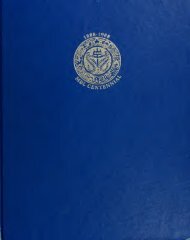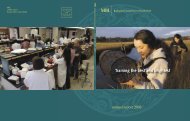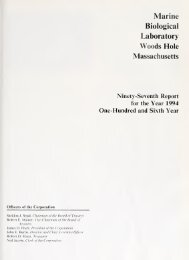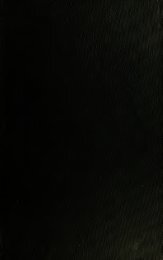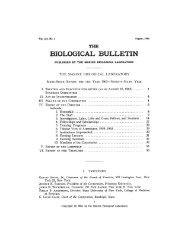View/Open - HPS Repository - Arizona State University
View/Open - HPS Repository - Arizona State University
View/Open - HPS Repository - Arizona State University
You also want an ePaper? Increase the reach of your titles
YUMPU automatically turns print PDFs into web optimized ePapers that Google loves.
R28<br />
LABORATORY OF BARBARA FURIE AND BRUCE FURIE<br />
|Pub/ications<br />
Brown, M., B. Hambe, B.<br />
Furie, B. C. Furie, J.<br />
Stenflo, and L M<br />
Stenberg. 2002. Detection<br />
of vitamin K-dependent<br />
in proteins venoms with a<br />
monoclonal antibody<br />
specific for p-<br />
carboxyglutamic acid,<br />
lexicon 40: 447-453,<br />
Czerwiec, E., G. S. Begley,<br />
J. Stenflo, K Taylor, B. C.<br />
Furie, and B Furie. 2002.<br />
Structural similarity and<br />
functional differences<br />
between invertebrate and<br />
vertebrate carboxylases:<br />
expression and characterization<br />
of recombinant<br />
vitamin K-dependent (Jglutamyl<br />
carboxylase from<br />
Conus textile. ur. J.<br />
Biochem. 269:6162-6172.<br />
P-Carboxyglutamic acid is a calcium-binding amino acid that is found<br />
in the conopeptides of the predatory marine cone snail, Conus.<br />
This<br />
laboratory has been investigating the biosynthesis of this amino acid in<br />
Conus and the structural role of p-carboxyglutamic acid in the<br />
conopeptides.<br />
This satellite laboratory relates closely to the main<br />
laboratory, the Center for Hemostasis and Thrombosis Research, on the<br />
Harvard Medical School campus in Boston, whose main focus is the<br />
[Staff<br />
synthesis and function of p-carboxyglutamic acid in blood clotting<br />
proteins and the role of vitamin K.<br />
Until recently, the marine cone snail had been the sole invertebrate<br />
known to synthesize the vitamin K-dependent amino acid, p--<br />
carboxyglutamic acid (Gla), but the work of this laboratory and others<br />
has shown that this synthetic pathway has been preserved in most animal phyla.<br />
ADJUNCT SCIENTISTS<br />
Barbara C. Furie. Harvard<br />
Medical School<br />
Bruce Furie, Harvard<br />
Medical School<br />
Alan Rigby, Harvard<br />
Medical School<br />
VISITING SCIENTIST<br />
Johan Stenflo, <strong>University</strong> of Lund<br />
STAFF SCIENTIST II<br />
Eva Czerwiec<br />
The cone snail<br />
produces neurotoxic conopeptides, some rich in Gla, which it<br />
injects into its prey to immobilize<br />
it. To examine the biosynthetic pathway for Gla, we have studied the Conus carboxylase which<br />
converts glutamic acid to p-carboxyglutamic acid in the presence of vitamin K. We examined<br />
the diversity of animal species that maintain vitamin K-dependent carboxylation to generate<br />
Gla. We have cloned full length carboxylase from the beluga whale (De/ph/napterus /eucas), the<br />
toadfish (Opsanus tau), and the cone snail (Conus text//e) to compare these structures to the<br />
known bovine, human, rat, and mouse cDNA sequences.<br />
In addition, we have partially cloned<br />
the carboxylase gene from chicken (Ga//us gallus), hagfish (Myxine g/ut/nosa), and horseshoe<br />
crab (L/mu/us po/yphemus).<br />
In addition, the Drosophi/a genome contains the p-carboxylase<br />
gene. The predicted amino acid sequence of the carboxylase cDNA from Conus textile shows<br />
most regions are nearly identical to the mammalian sequence, and that there is about 40%<br />
sequence similarity.<br />
This protein has been expressed, and the recombinant enzyme identified<br />
as a carboxylase and epoxidase. These results demonstrate the broad distribution of the vitamin<br />
Cone snails, Volker Steger<br />
-dependent carboxylase gene, including a highly conserved motif that is<br />
likely critical for<br />
enzyme function. The vitamin K-dependent biosynthesis of Gla is a highly conserved function in<br />
the animal kingdom and we are now searching for a novel Gla containing protein that is critical<br />
for survival of animal species.



